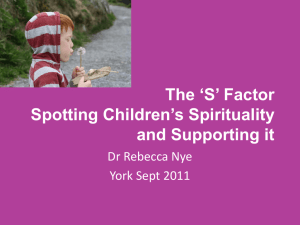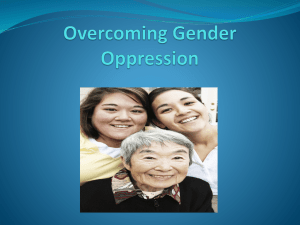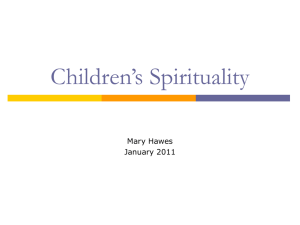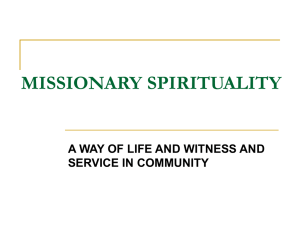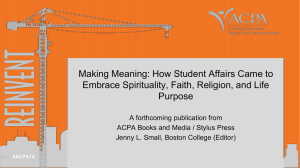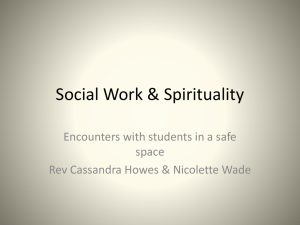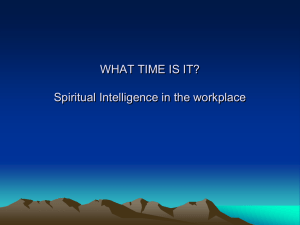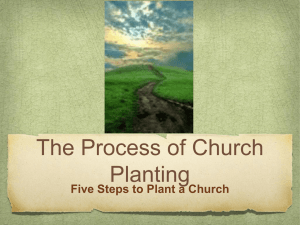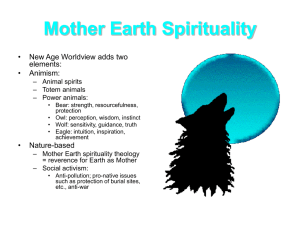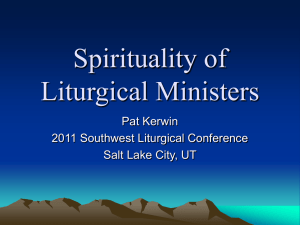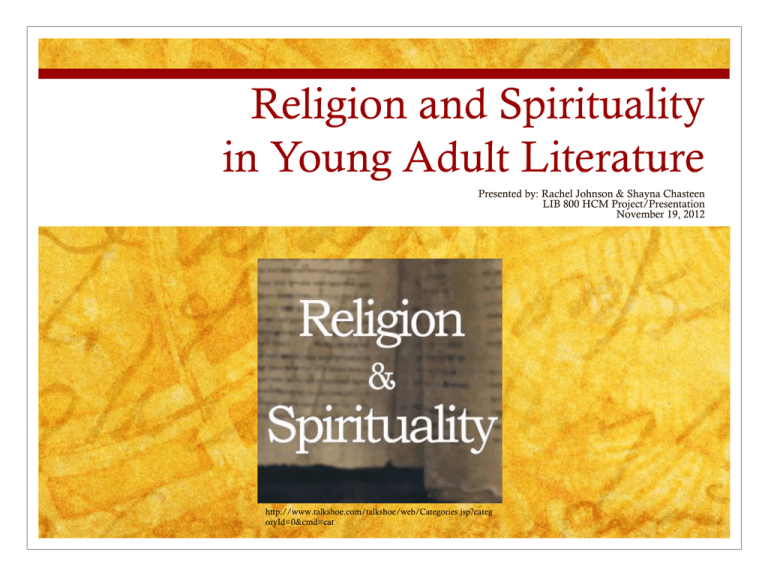
Religion and Spirituality
in Young Adult Literature
Presented by: Rachel Johnson & Shayna Chasteen
LIB 800 HCM Project/Presentation
November 19, 2012
http://www.talkshoe.com/talkshoe/web/Categories.jsp?categ
oryId=0&cmd=cat
Purpose
Explore religion and spirituality in young adult literature through
professional journal articles.
Discuss developmental issues and the audience related to religion
and spirituality in young adult literature.
Show how religion and spirituality has changed over the decades.
Discuss the current issues of religion and spirituality in young
adult literature.
Provide suggested reads related to religion and spirituality.
Expound on the topic by giving related websites/resources.
Discuss critical thinking questions as a class.
Journal Articles (Rachel)
Campbell P. Mainstreaming the last taboo. Horn Book
Magazine[serial online]. May 1998;74(3):379. Available
from: Academic Search Premier, Ipswich, MA. Accessed
October 8, 2012.
Cart, M. (2009). Carte Blanche: The Last Taboo?.
Booklist, 106(6), 32.
Mendt, K. L. Spiritual Themes in Young Adult
Books. The Alan Review. Spring 1996. 23(3).
Winner, L. F. (2001). Nurturing Today's Teen Spirit.
Publishers Weekly,248(11), 30.
Journal Articles (Shayna)
•
Campbell, P. (1994). The sand in the oyster. Horn Book Magazine,
70(5), 619-623.
•
Norton, N. & Simon, L. (2011). A mighty river: intersections of
spiritualties and activism in children’s and young adult literature.
Curriculum Inquiry, 293-318.
•
Sangwon, K. (2011). Adolescent spirituality and resilience: theory,
research, and educational practices. Psychology in the Schools, 48(7),
755-765.
•
Trousdale, A. (2005). Intersections of spirituality, religion. International
Journal of Children’s Spirituality,, 10(1), 61-79.
Definition of Terms
http://www.med.navy.mil/sites/nmcsd/nccosc/serviceMe
mbersV2/buildResilience/spiritualityItHelpsBuildResilienc
e/Pages/default.aspx
Spirituality- “is understood to be a
capacity in human beings for
wonderment, for experiencing or
pondering what might lie beyond the
visible, tangible aspects of reality; for
interest in the nature and origin of
things; and for considering how one is
to relate to others, to oneself, and to
the world about us” (Trousdale, 2005,
p. 63).
Religion- The belief in and worship of
a superhuman controlling power,
especially a God or gods.
Developmental Issues
According to research, most changes occur during
adolescence than any other time in human
development. These changes are not limited to physical
growth. Students this age also experience mental and
emotional growth as well (Sangwon, 2011).
Norton & Simon (2011) note within their research that
during this stage of development students being to
search for meaning in their lives and try to make sense
of their place in the world.
Much of this curiosity is driven from the urge to be their
own person. In other words, not driven by their
guardians.
Developmental Issues
For example, in the nonfiction book “World
Religions 101: An Overview for Teens” Margaret O.
Hyde and Emily G. Hyde (2009) discuss how teens
are searching for spiritual meaning and that the most
common path to spirituality is through religion.
Another example can be found in the fiction book,
“Everything You Need to Survive the Apocalypse”
where Lucas Klauss (2012) uses character, 16 year
old Phillip, to illustrate a teens search for meaning in
life and finding his place within the world.
Audience/Young Adult View
In the article, “Roses are Red Taking a Leap of
Faith”, Kay A. Smith interviews high school students
about religion and spirituality. She asks some of the
following questions:
Have you recently read a book that dealt with a
religious theme? Would you like to read a book that
dealt with the issues of religion, beliefs, morals, etc.?
Why or why not? How comfortable would you be
reading a book about all types of faith?
Audience/Young Adult View
The results: “surprising and fascinating”
(Smith, 2009).
From the articles we have read we infer that
religion and spirituality is not a popular
theme for adolescents. One can infer that
students want to search for spiritual
meaning, but don’t exactly know where to
go and the difference between religion and
spirituality.
http://www.episcopalswfl.org/Youth%20and%20Youn
g%20Adult/young-adult-ministry.html
Through the Decades…
http://www.biblestudyforyou.com/articles/
Spirituality began appearing in children’s books as
early as the 15th century in the way of the Lord’s
Prayer.
By the 19th century religion and spirituality were
common in children's books and looked like this in a
fiction book: ‘But the Bible tells us that God hates
pride. “Everyone that is proud is an abomination to
the Lord …”; “pride goeth before destruction and a
haughty spirit before a fall.” My great
desire for you is that you may learn to rule your own
spirit; that you may become meek
and lowly in heart, patient and gentle like the Lord”
(Trousdale, 2005, p. 61).
Through the Decades…
In the late 20th century, the way religion and
spirituality were presented in young adult literature
began to change.
Religious values began being replaced with the
inclusion of multicultural perspectives and of topics
formerly considered taboo in books for children:
divorce, drug and alcohol addiction, teenage
pregnancy, death of a parent or friend, mental
illness” (Trousdale, 2005, p. 63).
Through the Decades…
In current YA literature religion is most often
avoided all together and replaced with spirituality.
This approach is used to appeal to a wide variety and
offer skeptical questions that lead to uncertain
answers. In other words, most everything is open to
personal connection/interpretation (Trousdale, 2005,
p. 63).
After reading many articles and books, we have come
to the conclusion that religion and spirituality has
changed the way it is approached in young adult
literature.
Character Development
Through the Decades
Religious characters before the 20th century
http://www.frasersoft.net/family.htm
Often members of a stereotypical family (married
mother/father, siblings) that went to church regularly
and were portrayed as good moral people (Campbell,
1994).
Parents of the character, if applicable, were
considerate and knew what was going on with their
child, and offered guidance.
Character Development
Through the Decades
Current religious book characters:
Often portrayed as despicable
Intolerant of others religious views
Parents are often portrayed as gullible fanatics or
unbelievers who hinder the child’s god-search
Campbell, P. (1994). The sand in the oyster. Horn
Book Magazine, 70(5), 619-623.
Current Issues
When a character does search for faith how does it
turn out? Often badly with a total loss of faith.
Religion by nature is a private matter.
What are the dangers in leaving out religion? The
young reader will feel that they are the only one’s
working through their religion.
What accounts for the religion void in YA literature?
Publishers and writers risk cutting potential markets
by offending someone.
Current Issues
How can the lack of religious literature be
interpreted by young adults? That the topic does
not matter.
What is replacing God in YA literature?
Guardian angels, aliens, visitors beyond the
grave.
Fantasy is replacing spirituality.
If one truly wants to read a book about religion
then the reader will most likely need to look for
books published by a Christian publishing
company.
Suggested Fiction Reads
“
“Anna Dressed in Blood”
by Kendare Blake
“Island’s End”
by Padma Venkatraman
“Half World”
by Hiromi Goto
“Anna Dressed
In Blood”
Cas Lowood has inherited an
unusual vocation: He kills the dead.
Searching for a ghost the locals call
Anna Dressed in Blood, Cas
expects the usual: track, hunt, kill.
What he finds instead is a girl
entangled in curses and rage, a
ghost like he's never faced before
“Island’s End”
Uido becoming her tribe's spiritual
leader. Looming above many
troubles are the recent visits of
strangers from the mainland who
have little regard for nature or the
spirits, and tempt the tribe members
with gifts, making them curious about
modern life. Uido's little brother falls
deathly ill, she must cross the ocean
and seek their help. Having now seen
so many new things, will Uido have
the strength to believe in herself and
the old ways?
“Half World”
Melanie Tamaki is human but her
parents aren’t. They are from Half
World, a Limbo between our world
and the afterlife. When her mother
disappears, Melanie must follow
her to Half World and neither of
them may return alive.
Suggested Nonfiction Reads
“World Religions 101: An Overview for Teens”
By: Margaret O. Hyde and Emily G. Hyde
“Gandhi:a Manga Biography
By: Kazuki Ebine
“Religion and Spirituality in America: The
Ultimate Teen Guide
By: Kathlyn Gay
“World Religions 101:
An Overview for Teens
Examines the concept of
religions, how people
around the world practice
their religion, and how
religion affects people's
lives.
“Gandhi:
a Manga Biography”
In Gandhi, the third volume in our
exciting new manga biography
series, created in conjunction with
Emotional Content, Kazuki Ebine
combines a gripping narrative with
stunning illustrations to share
Gandhi's inspiring and deeply
human story with a whole new
generation of readers.
“Religion and Spirituality
in America:
The Ultimate Teen Guide”
Religion and Spirituality in
America: The Ultimate Teen Guide
provides an introduction to some of
the diverse religious practices,
traditions, and expressions in the
United States and focuses on how
teenagers view their particular
religious faith--or lack of it--what
they believe, what conflicts they
encounter, and how they relate to
others whose religions differ from
theirs.
Websites/Resources
http://www.goodreads.com/
http://rachel2188.wordpress.com/
http://www.youtube.com/watch?v=yooc38Zh8Kg&
list=HL1352204187&feature=mh_lolz (Booktalk –
Johnson)
http://spiritualityreads.wordpress.com/
https://www.youtube.com/watch?v=e3lCnrgwlcE
Questions
Why do you infer that religion/spirituality is taboo
in young adult literature?
What is your point of view about promoting books
with religious and spiritual content in the library?
From your experience as a Librarian or classroom
teacher, do spiritual/religious books get read or
requested often?
References
http://www.talkshoe.com/talkshoe/web/Categories.jsp?categoryId=0&cm
d=cat (religion and spirituality pic)
http://www.med.navy.mil/sites/nmcsd/nccosc/serviceMembersV2/buildR
esilience/spiritualityItHelpsBuildResilience/Pages/default.aspx (pic on slide
5)
Campbell P. Mainstreaming the last taboo. Horn Book Magazine[serial online].
May 1998;74(3):379. Available from: Academic Search Premier, Ipswich, MA.
Accessed October 8, 2012.
Campbell, P. (1994). The sand in the oyster. Horn Book Magazine, 70(5),
619-623.
Cart, M. (2009). Carte Blanche: The Last Taboo?. Booklist, 106(6), 32.
Mendt, K. L. Spiritual Themes in Young Adult Books. The Alan Review.
Spring 1996. 23(3). Winner, L. F. (2001). Nurturing Today's Teen Spirit.
Publishers Weekly,248(11), 30.
References
•
Norton, N. & Simon, L. (2011). A mighty river: intersections
of spiritualties and activism in children’s and young adult
literature. Curriculum Inquiry, 293-318.
•
Sangwon, K. (2011). Adolescent spirituality and resilience:
theory, research, and educational practices. Psychology in the
Schools, 48(7), 755-765.
•
Smith, K. (2009). Roses are Red Taking a Leap of Faith. The
Alan Review, 39 (2).
•
Trousdale, A. (2005). Intersections of spirituality, religion.
International Journal of Children’s Spirituality,, 10(1), 61-79.
•
Winner, L. F. (2001). Nurturing Today's Teen Spirit. Publishers
Weekly,248(11), 30.


